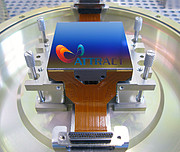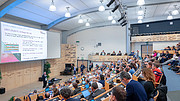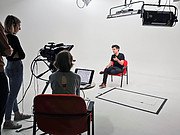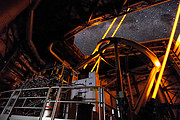Press Release
€17 million Fund Backs 170 Breakthrough Concepts in Imaging and Sensing
Successful proposals include projects highlighting societal benefits of ESO technology
23 May 2019
ATTRACT, a Horizon 2020 research and innovation project funded by the European Union and backed by a consortium of 9 partners including ESO, has announced 170 breakthrough ideas which will each receive €100,000 to develop technologies that have the potential to change society. The selected proposals include projects which highlight the societal benefits of ESO's astronomical expertise.
The projects selected for funding were drawn from a pool of more than 1200 proposals from researchers and entrepreneurs in scientific and industrial organisations across the world. An independent Research, Development and Innovation (R&D&I) Committee used a rigorous evaluation process to determine which of these proposals should receive €100,000 of funding.
“170 breakthrough ideas were selected based on a combination of scientific merit, innovation readiness and potential societal impact,” explained Sergio Bertolucci, chair of ATTRACT’s R&D&I Committee. “The idea is to speed up the process of developing breakthrough technologies and applying them to address society’s key challenges.”
ESO’s role as a partner in the ATTRACT consortium reflects its ongoing commitment to using astronomical technology to address societal challenges. The following selected ATTRACT projects highlight some of the societal applications of ESO's astronomical technology and expertise:
3D-CANCER-SPEC will bring astronomical technology to bear against cancer, one of the leading cause of death worldwide. This project — coordinated by Martin Roth of innoFSPEC at the Leibniz-Institut für Astrophysik Potsdam — will combine the expertise of two partners involved in the development of the innovative MUSE instrument on ESO’s Very Large Telescope. By doing so, the team will carry out a design study for an imaging spectrograph suitable for clinical cancer studies.
Spectroscopy is a powerful technique that can be used to determine the composition of an object from the light it emits, whether that light comes from an object in space or a person's body on Earth. Cancerous tissue differs enough from healthy tissue that it can be distinguished using Raman Spectroscopy — providing a promising way to avoid taking invasive tissue samples. While this has previously been shown to work in principle, the imaging process took hours, which is far too long to be practically useful. To make this process fast enough in a clinical setting, the team plans to apply a special technique of integral-field spectroscopy — as used by MUSE — developed to solve a particular challenge of astronomical imaging.
Single Photon Visible Light Image Sensors for Science and Technology seeks to lay the foundations for transformational changes in low-light imaging. This project, coordinated by Konstantin Stefanov of the Open University in partnership with ESO detector specialist Mark Downing, aims to develop single-photon visible-light imagers, suitable for adaptive optics systems and low-light level spectroscopic and imaging applications. The imaging performance of such sensors would be limited only by the photon absorption in the semiconductor and the quantum nature of light. By detecting and counting each and every photon without registering any additional noise, these sensors could offer the ultimate imaging performance — helping us see and discover the unknown.
“It’s wonderful to see how this technology used in ESO’s telescope instruments can be applied in a completely different field,” commented Andrew Williams, ESO’s representative on the ATTRACT Executive Board. “This is a key goal of the ATTRACT project, which provides seed funding to enable such ideas and continues the long tradition of fundamental research leading to innovative technologies that benefit society.”
From augmented reality to smart sensors and devices, many of the 170 ideas chosen will develop disruptive technologies that could help improve clinical diagnosis, health monitoring and personalised treatments for diseases such as cancer, Alzheimer’s, or malaria, as well as heart and neurological conditions.
Interdisciplinary teams of researchers, entrepreneurs and companies from across the globe will also develop novel sensors and devices that will enable radical innovations in many other sectors with high market potential. New technologies will include smart devices for environmental monitoring, green solutions to fight climate change, advanced applications for citizens, smart systems for manufacturing processes, and disruptive technologies to expand our scientific knowledge.
Details of the 170 funded projects are being released today, and are grouped into four broad categories: data acquisition systems and computing; front-end and back-end electronics; sensors; and software and integration.
Most of the breakthrough ideas — 64% — will develop next-generation technologies involving sensors, 16% will focus on data-acquisition systems and computing, 12% are software and integration projects, and 8% will develop the front and back-end electronics needed for the interfaces of sensors and imaging technology.
The 170 breakthrough projects funded by ATTRACT [1] will have one year to show that their disruptive ideas are worth further investment, and will present their results at a conference in autumn 2020 in Brussels. During the one-year development phase, business and innovation experts from the ATTRACT Project Consortium’s Aalto University, EIRMA, and ESADE Business School will help the project teams explore how their breakthrough technologies can be transformed into innovations with strong market potential.
Notes
[1] The ATTRACT initiative involves the European Organization for Nuclear Research (CERN), the European Molecular Biology Laboratory (EMBL), the European Southern Observatory (ESO), the European Synchrotron Radiation Facility (ESRF), the European XFEL, Institut Laue-Langevin (ILL), Aalto University, the European Industrial Research Management Association (EIRMA) and ESADE. The initiative is led by CERN and is funded by the European Union’s Horizon 2020 research and innovation programme.
More information
ESO is the foremost intergovernmental astronomy organisation in Europe and the world’s most productive ground-based astronomical observatory by far. It has 16 Member States: Austria, Belgium, Czechia, Denmark, France, Finland, Germany, Ireland, Italy, the Netherlands, Poland, Portugal, Spain, Sweden, Switzerland and the United Kingdom, along with the host state of Chile and with Australia as a Strategic Partner. ESO carries out an ambitious programme focused on the design, construction and operation of powerful ground-based observing facilities enabling astronomers to make important scientific discoveries. ESO also plays a leading role in promoting and organising cooperation in astronomical research. ESO operates three unique world-class observing sites in Chile: La Silla, Paranal and Chajnantor. At Paranal, ESO operates the Very Large Telescope and its world-leading Very Large Telescope Interferometer as well as two survey telescopes, VISTA working in the infrared and the visible-light VLT Survey Telescope. Also at Paranal ESO will host and operate the Cherenkov Telescope Array South, the world’s largest and most sensitive gamma-ray observatory. ESO is also a major partner in two facilities on Chajnantor, APEX and ALMA, the largest astronomical project in existence. And on Cerro Armazones, close to Paranal, ESO is building the 39-metre Extremely Large Telescope, the ELT, which will become “the world’s biggest eye on the sky”.
ATTRACT is a pioneering initiative bringing together Europe’s fundamental research and industrial communities to lead the next generation of detection and imaging technologies. Funded by the European Union’s Horizon 2020 programme under grant agreement No 777222, the project aims to help revamp Europe’s economy and improve people’s lives by creating products, services, companies and jobs. More info at www.attract-eu.com
Links
Contacts
Lars Lindberg Christensen
ESO Head of Outreach Initiatives
Garching bei München, Germany
Tel: +49 89 3200 6761
Cell: +49 173 38 72 621
Email: lars@eso.org
Virginia Mercouri
Media Adviser, Science|Business
Tel: +32 489 095 044
Email: virginia.mercouri@sciencebusiness.net
Anna Alsina Bardagí
Content Director, ESADE Business School
Tel: +34 690 957 506
Email: anna.alsina@esade.edu









